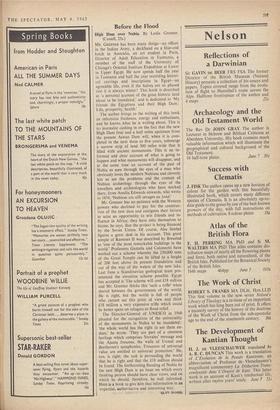Before the Flood
High Dam over Nubia. By Leslie Greener. (Cassell, 25s.) MR. GREENER has been many things—an officer in the Indian Army, a deckhand on a blue-cod ketch in Australia, an art student in Paris, Director of Adult Education in Tasmania, a member of the staff of the University of Chicago's Oriental Institute Expedition at Luxor in Upper Egypt. He now spends half the year in Tasmania and half the year recording histori- cal carvings and inscriptions in Egypt—an agreeable life, even if the halves are so phased that it is always winter! This book is described as 'a personal account of the great historic land about to be inundated,' and is dedicated to 'My friends the Egyptians and their High Dam : Life, prosperity, health.'
The author brings to the writing of this book an infectious freshness, energy and enthusiasm,.
and he knows what he is writing about. This is no journalist cashing in on the fact that the new High Dam four and a half miles upstream from the present Aswan Dam will, when it is com- pleted in the next three to five years, submerge a narrow strip of land 300 miles wide that is filled with ancient monuments. This is an in- formed and clear account of what is going to happen and what monuments will disappear, and at the same time an account of the past of Nubia as seen through the eyes of a man who obviously loves the modern Nubians and cleverly lets us see the problems and the content of Nubian archwology through the eyes of the travellers and archaeologists who have worked there, from Amelia Edwards onwards, who wrote in 1874, 'Nubians are still savages au fond.'
Mr. Greener has no patience with the Western
powers who declined to pay for the construc- tion of the new dam and castigates their failure to seize an opportunity to win friends and in- fluence in Africa; they have only themselves to biame, he says, that the project is being financed by the Soviet Union. Of course, Abu Simbel figures a great deal in his account. This great temple of Rameses II was described by Breasted as 'one of the most remarkable buildings in the world.' Professors Gazzola and Colonnetti have worked out a scheme whereby the 250,000 tons of the Great Temple can be lifted to a height of 200 feet above its present foundation and out of the way of the waters of the new lake. Last June a Scandinavian geological team pro- nounced the elevation scheme possible. Egypt has accepted it. The scheme will cost £18 million and Mr. Greener thinks this 'such a trifle' when shared between the governments of the world. He is right, but the world is full of people who cannot see this point of view and think £18 million a very expensive trifle which could be better spent on refugees or flood relief.
The Director-General of . UNESCO in 1960 pleaded for the recognition of the universality of the monuments in Nubia to be inundated:
'the whole world has the right to see them en- dure,' he wrote. 'They are part of a common heritage which comprises Socrates' message and the Ajanta frescoes, the walls of Uxmal and Beethoven's symphonies. Treasures of universal value are entitled to universal protection.' He, too, is right; the task is persuading the world that he is right and that the £18 million should be found. The forthcoming flooding of Nubia by the new High Dam is an issue on which every thinking person should have clear views, and on which he should, therefore, be well informed. Here is a book to give him that information in an impartial, authoritative and interesting way. ;tx., OLYN DANIEL






































 Previous page
Previous page